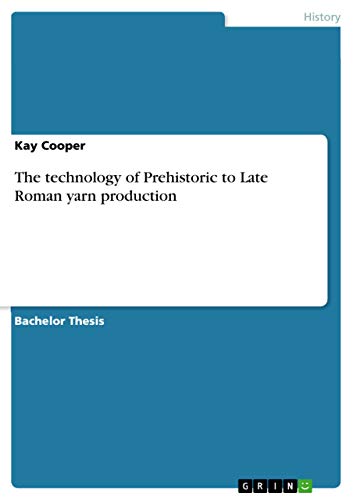The technology of Prehistoric to Late Roman yarn production - Tapa blanda

"Sobre este título" puede pertenecer a otra edición de este libro.
- EditorialGRIN Verlag
- Año de publicación2010
- ISBN 10 3640761286
- ISBN 13 9783640761289
- EncuadernaciónTapa blanda
- Número de edición2
- Número de páginas112
Comprar nuevo
Ver este artículo
Gastos de envío:
EUR 23,00
De Alemania a Estados Unidos de America
Los mejores resultados en AbeBooks
The technology of Prehistoric to Late Roman yarn production
Descripción Taschenbuch. Condición: Neu. This item is printed on demand - it takes 3-4 days longer - Neuware -Bachelor Thesis from the year 2009 in the subject Archaeology, grade: 2.1, University of Nottingham, course: B.A Honours, language: English, abstract: Within this dissertation, I shall be considering the technology of prehistoric to Late Roman yarn production. To understand any textile, you first need to understand the components, from which it is constructed. At the base level are the fibres that are gathered and processed and then spun to make the yarn, which eventually will be woven into a completed textile. These fibres include tree and plant basts, animal hair and more obscure varieties, such as mineral and mollusc fibres.In the first two chapters, I shall be considering how these fibres were gathered and processed, prior to being spun. I will begin with a consideration of bast fibres and then move on to mineral and animal fibres, including both evidence from archaeological finds and textual references from ancient writers such as Pliny the Elder.In chapter 3, I will discuss the beginnings of the evolution of yarn from its earliest phases. This includes the hand twisting of fibres to form string and cord, which was the forerunner to yarn. Hopefully, this will provide an anthropological context to the subject. The evidence for string and cord comes predominantly from archaeological finds, including pottery.Finally, I shall consider the art of spinning, the archaeological evidence for the spinning process and its interpretation. This will include weaving or spinning bowls, distaffs and spindle whorls and evidence from pottery, art, literature and completed textiles.This dissertation will include evidence predominantly from Europe. However, I will also consider, in part, the wider ethnographical evidence, from places such as Mesopotamia and Egypt, in order to provide an insight into the global context. 112 pp. Englisch. Nº de ref. del artículo: 9783640761289
The technology of Prehistoric to Late Roman yarn production
Descripción Taschenbuch. Condición: Neu. Druck auf Anfrage Neuware - Printed after ordering - Bachelor Thesis from the year 2009 in the subject Archaeology, grade: 2.1, University of Nottingham, course: B.A Honours, language: English, abstract: Within this dissertation, I shall be considering the technology of prehistoric to Late Roman yarn production. To understand any textile, you first need to understand the components, from which it is constructed. At the base level are the fibres that are gathered and processed and then spun to make the yarn, which eventually will be woven into a completed textile. These fibres include tree and plant basts, animal hair and more obscure varieties, such as mineral and mollusc fibres.In the first two chapters, I shall be considering how these fibres were gathered and processed, prior to being spun. I will begin with a consideration of bast fibres and then move on to mineral and animal fibres, including both evidence from archaeological finds and textual references from ancient writers such as Pliny the Elder.In chapter 3, I will discuss the beginnings of the evolution of yarn from its earliest phases. This includes the hand twisting of fibres to form string and cord, which was the forerunner to yarn. Hopefully, this will provide an anthropological context to the subject. The evidence for string and cord comes predominantly from archaeological finds, including pottery.Finally, I shall consider the art of spinning, the archaeological evidence for the spinning process and its interpretation. This will include weaving or spinning bowls, distaffs and spindle whorls and evidence from pottery, art, literature and completed textiles.This dissertation will include evidence predominantly from Europe. However, I will also consider, in part, the wider ethnographical evidence, from places such as Mesopotamia and Egypt, in order to provide an insight into the global context. Nº de ref. del artículo: 9783640761289

